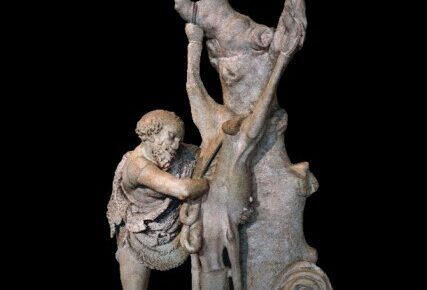
Do you think with your heart or with your head? Far from a metaphorical question, this debate roiled ancient medicine at a very literal level. The topic of where, precisely, the soul interfaced with the body was a contentious one, with many arguing for the brain but many others rooting for the heart in all its centralized glory. Galen of Pergamon the Greek speaking doctor who lived and worked in Imperial Rome and whose massive oeuvre dominated the subsequent millennium and a half of medical history had an impressive answer. Not content, like some, to argue logically or theoretically, he instead opted to demonstrate his position on the bodies of living animals, to the embarrassment of his rivals and the amazement of his spectators. On numerous occasions, he tells us, he enlivened his debates with his peers by bringing in a large animal and proceeding to remove the top of its skull and expose its brain. Once exposed, he pressed on different locations with dramatic results: press here and the effect is minimal but press here and the animal becomes all but unconscious! Pick just the right spot, and it immediately goes blind. Take the same animal, however now admittedly a bit worse for the wear and expose its heart, and the results are dramatically different. No matter how hard you squeeze the heart, it has no effect on the animal’s consciousness or motor capacity. Like a true showman, Galen even invites his audience to try. He passes out a pair of bronze tongs and encourages his volunteer to grasp the heart as hard as he is able, but still the result is the same: a clear victory for the dominance of the brain. This was not the only vivisectory demonstration in Galen’s arsenal. He manipulated nerves, arteries, ureters anything that could serve to offer unequivocal and unforgettable proof of his assertions. Nor was Galen’s undoubtedly effective approach eccentric; he was but one of many active anatomists in his lifetime. Dissection and vivisection formed a small but visible part of the spectacle of Ancient Imperial Rome.
My new book, Dissection in Classical Antiquity: A Social and Medical History, uncovers this hitherto underappreciated landscape of dissective activity in the classical world. Ranging from Classical Greece to Late Antiquity, the first half of the book traces the development and increasing popularity of dissection as a methodology for answering questions about both the anatomy and the functioning of the human body. Though we think of dissection as the obvious source of anatomical knowledge, Greek medical and philosophical writing already had theoretical conceptualizations of the internal organs before dissection came to be regularly practiced. Even as it grew in popularity during the Hellenistic period with Aristotle systematically dissecting as much of the animal kingdom as he could get his hands on and Herophilus and Erasistratus daringly broaching human subjects it remained a contentious practice, only one way of many to understand the viscera’s form and function. The Roman period, when Galen and his peers deployed dissection and vivisection both heuristically and performatively, saw the most vibrant levels of popularity of dissection, practiced on animals as proxies for the human body. But whenever and wherever dissections occurred, they were embedded within their social surroundings. Dissectors had to distinguish themselves from diviners, who also sought knowledge from animal entrails; from magicians, who harvested animal organs for their spells with expert precision; from butchers, who were intimately familiar with these same organs, though for vastly different reasons.
For all that we can reconstruct these ancient dissections and vivisections and their contexts, however, they were necessarily evanescent phenomena. There are no discernable material traces of these activities: you had to be there. The anatomical literature of antiquity which forms the focus of the second half of the book sought, in part, to address this problem. Sadly, the anatomical literature ended up, for a variety of reasons, being almost as evanescent as the anatomical feats. Even Galen’s anatomical writing, which was largely responsible for the eclipse of everyone else’s, does not survive intact. Unravelling the history of these lost texts becomes something of a ghost hunt, but enough evidence remains to reveal the outlines of a robust and varied genre, deep in conversation with itself and often but not always with the practice of dissection. The longest and most sophisticated anatomical text to survive marks the final merging of these two fields. Galen’s Anatomical Procedures offers fifteen volumes of instruction on how to dissect and vivisect every anatomical element of the body, deploying monkeys and other animals to reveal the hidden structures of the human body. Indeed, it is from this text that we have his most detailed description of (and instructions for) the aggressive brain and heart vivisections with which I began. Though the impact of these tactics on his audience was enormous, it, too, was transient. Galen wants you to be able to reproduce them for yourself: the brain, after all, must be defended.
Latest Comments
Have your say!